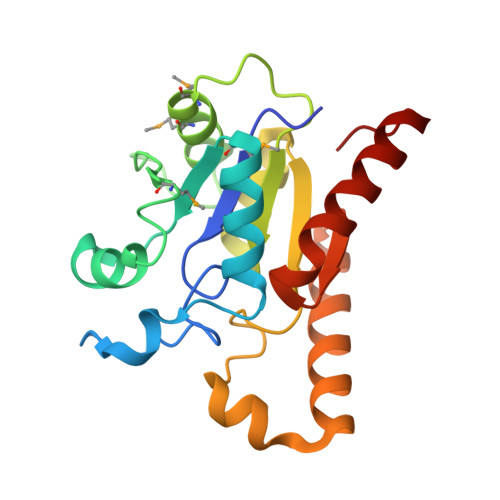The X-ray crystallographic structure and activity analysis of a Pseudomonas-specific subfamily of the HAD enzyme superfamily evidences a novel biochemical function.
Peisach, E., Wang, L., Burroughs, A.M., Aravind, L., Dunaway-Mariano, D., Allen, K.N.(2007) Proteins 70: 197-207
- PubMed: 17654544
- DOI: https://doi.org/10.1002/prot.21583
- Primary Citation of Related Structures:
2ODA - PubMed Abstract:
The haloacid dehalogenase (HAD) superfamily is a large family of proteins dominated by phosphotransferases. Thirty-three sequence families within the HAD superfamily (HADSF) have been identified to assist in function assignment. One such family includes the enzyme phosphoacetaldehyde hydrolase (phosphonatase). Phosphonatase possesses the conserved Rossmanniod core domain and a C1-type cap domain. Other members of this family do not possess a cap domain and because the cap domain of phosphonatase plays an important role in active site desolvation and catalysis, the function of the capless family members must be unique. A representative of the capless subfamily, PSPTO_2114, from the plant pathogen Pseudomonas syringae, was targeted for catalytic activity and structure analyses. The X-ray structure of PSPTO_2114 reveals a capless homodimer that conserves some but not all of the intersubunit contacts contributed by the core domains of the phosphonatase homodimer. The region of the PSPTO_2114 that corresponds to the catalytic scaffold of phosphonatase (and other HAD phosphotransfereases) positions amino acid residues that are ill suited for Mg+2 cofactor binding and mediation of phosphoryl group transfer between donor and acceptor substrates. The absence of phosphotransferase activity in PSPTO_2114 was confirmed by kinetic assays. To explore PSPTO_2114 function, the conservation of sequence motifs extending outside of the HADSF catalytic scaffold was examined. The stringently conserved residues among PSPTO_2114 homologs were mapped onto the PSPTO_2114 three-dimensional structure to identify a surface region unique to the family members that do not possess a cap domain. The hypothesis that this region is used in protein-protein recognition is explored to define, for the first time, HADSF proteins which have acquired a function other than that of a catalyst.
Organizational Affiliation:
Department of Physiology and Biophysics, Boston University School of Medicine, 715 Albany Street, Boston, Massachusetts 02118-2394, USA.

















